UNIT- 2
Conditional Branching and Loops
Conditional Branching
If else Statement
The if-else statement in C is used to perform the operations based on some specific condition. The operations specified in if block are executed if and only if the given condition is true.
There are the following variants of if statement in C language.
- If statement
- If-else statement
- If else-if ladder
- Nested if
If Statement
The if statement is used to check some given condition and perform some operations depending upon the correctness of that condition. It is mostly used in the scenario where we need to perform the different operations for the different conditions. The syntax of the if statement is given below.
- If(expression){
- //code to be executed
- }
Flowchart of if statement in C
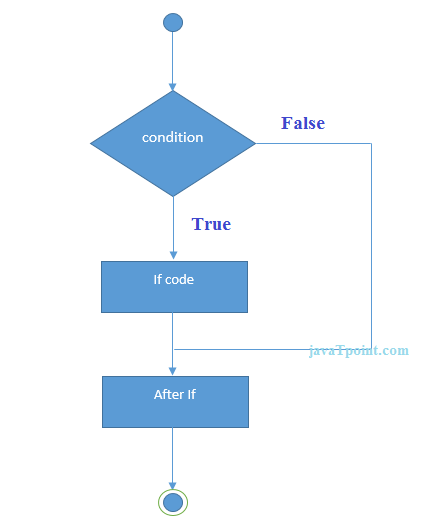
Let's see a simple example of C language if statement.
- #include<stdio.h>
- Int main(){
- Int number=0;
- Printf("Enter a number:");
- Scanf("%d",&number);
- If(number%2==0){
- Printf("%d is even number",number);
- }
- Return 0;
- }
Output
Enter a number:4
4 is even number
Enter a number:5
Program to find the largest number of the three.
- #include <stdio.h>
- Int main()
- {
- Int a, b, c;
- Printf("Enter three numbers?");
- Scanf("%d %d %d",&a,&b,&c);
- If(a>b && a>c)
- {
- Printf("%d is largest",a);
- }
- If(b>a && b > c)
- {
- Printf("%d is largest",b);
- }
- If(c>a && c>b)
- {
- Printf("%d is largest",c);
- }
- If(a == b && a == c)
- {
- Printf("All are equal");
- }
- }
Output
Enter three numbers?
12 23 34
34 is largest
If-else Statement
The if-else statement is used to perform two operations for a single condition. The if-else statement is an extension to the if statement using which, we can perform two different operations, i.e., one is for the correctness of that condition, and the other is for the incorrectness of the condition. Here, we must notice that if and else block cannot be executed simultaneously. Using if-else statement is always preferable since it always invokes an otherwise case with every if condition. The syntax of the if-else statement is given below.
- If(expression){
- //code to be executed if condition is true
- }else{
- //code to be executed if condition is false
- }
Flowchart of the if-else statement in C
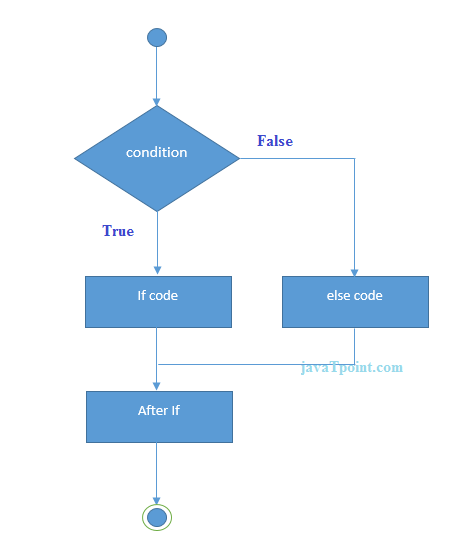
Let's see the simple example to check whether a number is even or odd using if-else statement in C language.
- #include<stdio.h>
- Int main(){
- Int number=0;
- Printf("enter a number:");
- Scanf("%d",&number);
- If(number%2==0){
- Printf("%d is even number",number);
- }
- Else{
- Printf("%d is odd number",number);
- }
- Return 0;
- }
Output
Enter a number:4
4 is even number
Enter a number:5
5 is odd number
Program to check whether a person is eligible to vote or not.
- #include <stdio.h>
- Int main()
- {
- Int age;
- Printf("Enter your age?");
- Scanf("%d",&age);
- If(age>=18)
- {
- Printf("You are eligible to vote...");
- }
- Else
- {
- Printf("Sorry ... you can't vote");
- }
- }
Output
Enter your age?18
You are eligible to vote...
Enter your age?13
Sorry ... You can't vote
If else-if ladder Statement
The if-else-if ladder statement is an extension to the if-else statement. It is used in the scenario where there are multiple cases to be performed for different conditions. In if-else-if ladder statement, if a condition is true then the statements defined in the if block will be executed, otherwise if some other condition is true then the statements defined in the else-if block will be executed, at the last if none of the condition is true then the statements defined in the else block will be executed. There are multiple else-if blocks possible. It is similar to the switch case statement where the default is executed instead of else block if none of the cases is matched.
- If(condition1){
- //code to be executed if condition1 is true
- }else if(condition2){
- //code to be executed if condition2 is true
- }
- Else if(condition3){
- //code to be executed if condition3 is true
- }
- ...
- Else{
- //code to be executed if all the conditions are false
- }
Flowchart of else-if ladder statement in C

The example of an if-else-if statement in C language is given below.
- #include<stdio.h>
- Int main(){
- Int number=0;
- Printf("enter a number:");
- Scanf("%d",&number);
- If(number==10){
- Printf("number is equals to 10");
- }
- Else if(number==50){
- Printf("number is equal to 50");
- }
- Else if(number==100){
- Printf("number is equal to 100");
- }
- Else{
- Printf("number is not equal to 10, 50 or 100");
- }
- Return 0;
- }
Output
Enter a number:4
Number is not equal to 10, 50 or 100
Enter a number:50
Number is equal to 50
Program to calculate the grade of the student according to the specified marks.
- #include <stdio.h>
- Int main()
- {
- Int marks;
- Printf("Enter your marks?");
- Scanf("%d",&marks);
- If(marks > 85 && marks <= 100)
- {
- Printf("Congrats ! you scored grade A ...");
- }
- Else if (marks > 60 && marks <= 85)
- {
- Printf("You scored grade B + ...");
- }
- Else if (marks > 40 && marks <= 60)
- {
- Printf("You scored grade B ...");
- }
- Else if (marks > 30 && marks <= 40)
- {
- Printf("You scored grade C ...");
- }
- Else
- {
- Printf("Sorry you are fail ...");
- }
- }
Output
Enter your marks?10
Sorry you are fail ...
Enter your marks?40
You scored grade C ...
Enter your marks?90
Congrats! you scored grade A ...
Switch Statement
The switch statement in C is an alternate to if-else-if ladder statement which allows us to execute multiple operations for the different possible values of a single variable called switch variable. Here, We can define various statements in the multiple cases for the different values of a single variable.
The syntax of switch statement is given below:
- Switch(expression){
- Case value1:
- //code to be executed;
- Break; //optional
- Case value2:
- //code to be executed;
- Break; //optional
- ......
- Default:
- Code to be executed if all cases are not matched;
- }
Rules for switch statement in C language
1) The switch expression must be of an integer or character type.
2) The case value must be an integer or character constant.
3) The case value can be used only inside the switch statement.
4) The break statement in switch case is not must. It is optional. If there is no break statement found in the case, all the cases will be executed present after the matched case. It is known as fall through the state of C switch statement.
Let's try to understand it by the examples. We are assuming that there are following variables.
- Int x,y,z;
- Char a,b;
- Float f;
Valid Switch | Invalid Switch | Valid Case | Invalid Case |
Switch(x) | Switch(f) | Case 3; | Case 2.5; |
Switch(x>y) | Switch(x+2.5) | Case 'a'; | Case x; |
Switch(a+b-2) |
| Case 1+2; | Case x+2; |
Switch(func(x,y)) |
| Case 'x'>'y'; | Case 1,2,3; |
Flowchart of switch statement in C

Functioning of switch case statement
First, the integer expression specified in the switch statement is evaluated. This value is then matched one by one with the constant values given in the different cases. If a match is found, then all the statements specified in that case are executed along with the all the cases present after that case including the default statement. No two cases can have similar values. If the matched case contains a break statement, then all the cases present after that will be skipped, and the control comes out of the switch. Otherwise, all the cases following the matched case will be executed.
Let's see a simple example of c language switch statement.
- #include<stdio.h>
- Int main(){
- Int number=0;
- Printf("enter a number:");
- Scanf("%d",&number);
- Switch(number){
- Case 10:
- Printf("number is equals to 10");
- Break;
- Case 50:
- Printf("number is equal to 50");
- Break;
- Case 100:
- Printf("number is equal to 100");
- Break;
- Default:
- Printf("number is not equal to 10, 50 or 100");
- }
- Return 0;
- }
Output
Enter a number:4
Number is not equal to 10, 50 or 100
Enter a number:50
Number is equal to 50
Switch case example 2
- #include <stdio.h>
- Int main()
- {
- Int x = 10, y = 5;
- Switch(x>y && x+y>0)
- {
- Case 1:
- Printf("hi");
- Break;
- Case 0:
- Printf("bye");
- Break;
- Default:
- Printf(" Hello bye ");
- }
- }
Output
Hi
C Switch statement is fall-through
In C language, the switch statement is fall through; it means if you don't use a break statement in the switch case, all the cases after the matching case will be executed.
Let's try to understand the fall through state of switch statement by the example given below.
- #include<stdio.h>
- Int main(){
- Int number=0;
- Printf("enter a number:");
- Scanf("%d",&number);
- Switch(number){
- Case 10:
- Printf("number is equal to 10\n");
- Case 50:
- Printf("number is equal to 50\n");
- Case 100:
- Printf("number is equal to 100\n");
- Default:
- Printf("number is not equal to 10, 50 or 100");
- }
- Return 0;
- }
Output
Enter a number:10
Number is equal to 10
Number is equal to 50
Number is equal to 100
Number is not equal to 10, 50 or 100
Output
Enter a number:50
Number is equal to 50
Number is equal to 100
Number is not equal to 10, 50 or 100
Nested switch case statement
We can use as many switch statements as we want inside a switch statement. Such type of statements is called nested switch case statements. Consider the following example.
- #include <stdio.h>
- Int main () {
- Int i = 10;
- Int j = 20;
- Switch(i) {
- Case 10:
- Printf("the value of i evaluated in outer switch: %d\n",i);
- Case 20:
- Switch(j) {
- Case 20:
- Printf("The value of j evaluated in nested switch: %d\n",j);
- }
- }
- Printf("Exact value of i is : %d\n", i );
- Printf("Exact value of j is : %d\n", j );
- Return 0;
- }
Output
The value of i evaluated in outer switch: 10
The value of j evaluated in nested switch: 20
Exact value of i is : 10
Exact value of j is : 20
If-else vs switch
What is an if-else statement?
An if-else statement in C programming is a conditional statement that executes a different set of statements based on the condition that is true or false. The 'if' block will be executed only when the specified condition is true, and if the specified condition is false, then the else block will be executed.
Syntax of if-else statement is given below:
- If(expression)
- {
- // statements;
- }
- Else
- {
- // statements;
- }
What is a switch statement?
A switch statement is a conditional statement used in C programming to check the value of a variable and compare it with all the cases. If the value is matched with any case, then its corresponding statements will be executed. Each case has some name or number known as the identifier. The value entered by the user will be compared with all the cases until the case is found. If the value entered by the user is not matched with any case, then the default statement will be executed.
Syntax of the switch statement is given below:
- Switch(expression)
- {
- Case constant 1:
- // statements;
- Break;
- Case constant 2:
- // statements;
- Break;
- Case constant n:
- // statements;
- Break;
- Default:
- // statements;
- }
Similarity b/w if-else and switch
Both the if-else and switch are the decision-making statements. Here, decision-making statements mean that the output of the expression will decide which statements are to be executed.
Differences b/w if-else and switch statement
The following are the differences between if-else and switch statement are:
- Definition
If-else
Based on the result of the expression in the 'if-else' statement, the block of statements will be executed. If the condition is true, then the 'if' block will be executed otherwise 'else' block will execute.
Switch statement
The switch statement contains multiple cases or choices. The user will decide the case, which is to execute.
- Expression
If-else
It can contain a single expression or multiple expressions for multiple choices. In this, an expression is evaluated based on the range of values or conditions. It checks both equality and logical expressions.
Switch
It contains only a single expression, and this expression is either a single integer object or a string object. It checks only equality expression.
- Evaluation
If-else
An if-else statement can evaluate almost all the types of data such as integer, floating-point, character, pointer, or Boolean.
Switch
A switch statement can evaluate either an integer or a character.
- Sequence of Execution
If-else
In the case of 'if-else' statement, either the 'if' block or the 'else' block will be executed based on the condition.
Switch
In the case of the 'switch' statement, one case after another will be executed until the break keyword is not found, or the default statement is executed.
- Default Execution
If-else
If the condition is not true within the 'if' statement, then by default, the else block statements will be executed.
Switch
If the expression specified within the switch statement is not matched with any of the cases, then the default statement, if defined, will be executed.
- Values
If-else
Values are based on the condition specified inside the 'if' statement. The value will decide either the 'if' or 'else' block is to be executed.
Switch
In this case, value is decided by the user. Based on the choice of the user, the case will be executed.
- Use
If-else
It evaluates a condition to be true or false.
Switch
A switch statement compares the value of the variable with multiple cases. If the value is matched with any of the cases, then the block of statements associated with this case will be executed.
- Editing
If-else
Editing in 'if-else' statement is not easy as if we remove the 'else' statement, then it will create the havoc.
Switch
Editing in switch statement is easier as compared to the 'if-else' statement. If we remove any of the cases from the switch, then it will not interrupt the execution of other cases. Therefore, we can say that the switch statement is easy to modify and maintain.
- Speed
If-else
If the choices are multiple, then the speed of the execution of 'if-else' statements is slow.
Switch
The case constants in the switch statement create a jump table at the compile time. This jump table chooses the path of the execution based on the value of the expression. If we have a multiple choice, then the execution of the switch statement will be much faster than the equivalent logic of 'if-else' statement.
Let's summarize the above differences in a tabular form.
| If-else | Switch |
Definition | Depending on the condition in the 'if' statement, 'if' and 'else' blocks are executed. | The user will decide which statement is to be executed. |
Expression | It contains either logical or equality expression. | It contains a single expression which can be either a character or integer variable. |
Evaluation | It evaluates all types of data, such as integer, floating-point, character or Boolean. | It evaluates either an integer, or character. |
Sequence of execution | First, the condition is checked. If the condition is true then 'if' block is executed otherwise 'else' block | It executes one case after another till the break keyword is not found, or the default statement is executed. |
Default execution | If the condition is not true, then by default, else block will be executed. | If the value does not match with any case, then by default, default statement is executed. |
Editing | Editing is not easy in the 'if-else' statement. | Cases in a switch statement are easy to maintain and modify. Therefore, we can say that the removal or editing of any case will not interrupt the execution of other cases. |
Speed | If there are multiple choices implemented through 'if-else', then the speed of the execution will be slow. | If we have multiple choices then the switch statement is the best option as the speed of the execution will be much higher than 'if-else'. |
Loops
The looping can be defined as repeating the same process multiple times until a specific condition satisfies. There are three types of loops used in the C language. In this part of the tutorial, we are going to learn all the aspects of C loops.
Why use loops in C language?
The looping simplifies the complex problems into the easy ones. It enables us to alter the flow of the program so that instead of writing the same code again and again, we can repeat the same code for a finite number of times. For example, if we need to print the first 10 natural numbers then, instead of using the printf statement 10 times, we can print inside a loop which runs up to 10 iterations.
Advantage of loops in C
1) It provides code reusability.
2) Using loops, we do not need to write the same code again and again.
3) Using loops, we can traverse over the elements of data structures (array or linked lists).
Types of C Loops
There are three types of loops in C language that is given below:
- Do while
- While
- For
Do-while loop in C
The do-while loop continues until a given condition satisfies. It is also called post tested loop. It is used when it is necessary to execute the loop at least once (mostly menu driven programs).
The syntax of do-while loop in c language is given below:
- Do{
- //code to be executed
- }while(condition);
While loop in C
The while loop in c is to be used in the scenario where we don't know the number of iterations in advance. The block of statements is executed in the while loop until the condition specified in the while loop is satisfied. It is also called a pre-tested loop.
The syntax of while loop in c language is given below:
- While(condition){
- //code to be executed
- }
For loop in C
The for loop is used in the case where we need to execute some part of the code until the given condition is satisfied. The for loop is also called as a per-tested loop. It is better to use for loop if the number of iteration is known in advance.
The syntax of for loop in c language is given below:
- For(initialization;condition;incr/decr){
- //code to be executed
- }
Do while loop
The do while loop is a post tested loop. Using the do-while loop, we can repeat the execution of several parts of the statements. The do-while loop is mainly used in the case where we need to execute the loop at least once. The do-while loop is mostly used in menu-driven programs where the termination condition depends upon the end user.
Do while loop syntax
The syntax of the C language do-while loop is given below:
- Do{
- //code to be executed
- }while(condition);
Example 1
- #include<stdio.h>
- #include<stdlib.h>
- Void main ()
- {
- Char c;
- Int choice,dummy;
- Do{
- Printf("\n1. Print Hello\n2. Print Javatpoint\n3. Exit\n");
- Scanf("%d",&choice);
- Switch(choice)
- {
- Case 1 :
- Printf("Hello");
- Break;
- Case 2:
- Printf("Javatpoint");
- Break;
- Case 3:
- Exit(0);
- Break;
- Default:
- Printf("please enter valid choice");
- }
- Printf("do you want to enter more?");
- Scanf("%d",&dummy);
- Scanf("%c",&c);
- }while(c=='y');
- }
Output
1. Print Hello
2. Print Javatpoint
3. Exit
1
Hello
Do you want to enter more?
y
1. Print Hello
2. Print Javatpoint
3. Exit
2
Javatpoint
Do you want to enter more?
n
Flowchart of do while loop
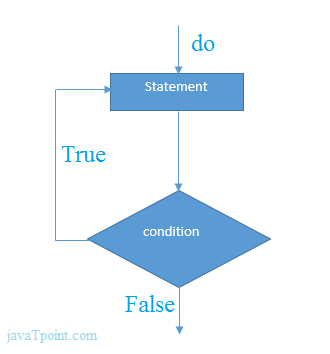
do while example
There is given the simple program of c language do while loop where we are printing the table of 1.
- #include<stdio.h>
- Int main(){
- Int i=1;
- Do{
- Printf("%d \n",i);
- i++;
- }while(i<=10);
- Return 0;
- }
Output
1
2
3
4
5
6
7
8
9
10
Program to print table for the given number using do while loop
- #include<stdio.h>
- Int main(){
- Int i=1,number=0;
- Printf("Enter a number: ");
- Scanf("%d",&number);
- Do{
- Printf("%d \n",(number*i));
- i++;
- }while(i<=10);
- Return 0;
- }
Output
Enter a number: 5
5
10
15
20
25
30
35
40
45
50
Enter a number: 10
10
20
30
40
50
60
70
80
90
100
Infinitive do while loop
The do-while loop will run infinite times if we pass any non-zero value as the conditional expression.
- Do{
- //statement
- }while(1);
While loop
While loop is also known as a pre-tested loop. In general, a while loop allows a part of the code to be executed multiple times depending upon a given boolean condition. It can be viewed as a repeating if statement. The while loop is mostly used in the case where the number of iterations is not known in advance.
Syntax of while loop in C language
The syntax of while loop in c language is given below:
- While(condition){
- //code to be executed
- }
Flowchart of while loop in C
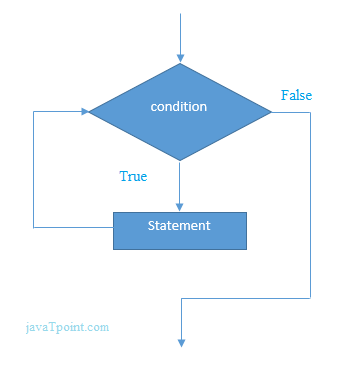
Example of the while loop in C language
Let's see the simple program of while loop that prints table of 1.
- #include<stdio.h>
- Int main(){
- Int i=1;
- While(i<=10){
- Printf("%d \n",i);
- i++;
- }
- Return 0;
- }
Output
1
2
3
4
5
6
7
8
9
10
Program to print table for the given number using while loop in C
- #include<stdio.h>
- Int main(){
- Int i=1,number=0,b=9;
- Printf("Enter a number: ");
- Scanf("%d",&number);
- While(i<=10){
- Printf("%d \n",(number*i));
- i++;
- }
- Return 0;
- }
Output
Enter a number: 50
50
100
150
200
250
300
350
400
450
500
Enter a number: 100
100
200
300
400
500
600
700
800
900
1000
Properties of while loop
- A conditional expression is used to check the condition. The statements defined inside the while loop will repeatedly execute until the given condition fails.
- The condition will be true if it returns 0. The condition will be false if it returns any non-zero number.
- In while loop, the condition expression is compulsory.
- Running a while loop without a body is possible.
- We can have more than one conditional expression in while loop.
- If the loop body contains only one statement, then the braces are optional.
Example 1
- #include<stdio.h>
- Void main ()
- {
- Int j = 1;
- While(j+=2,j<=10)
- {
- Printf("%d ",j);
- }
- Printf("%d",j);
- }
Output
3 5 7 9 11
Example 2
- #include<stdio.h>
- Void main ()
- {
- While()
- {
- Printf("hello Javatpoint");
- }
- }
Output
Compile time error: while loop can't be empty
Example 3
- #include<stdio.h>
- Void main ()
- {
- Int x = 10, y = 2;
- While(x+y-1)
- {
- Printf("%d %d",x--,y--);
- }
- }
Output
Infinite loop
Infinitive while loop in C
If the expression passed in while loop results in any non-zero value then the loop will run the infinite number of times.
- While(1){
- //statement
- }
For loop
The for loop in C language is used to iterate the statements or a part of the program several times. It is frequently used to traverse the data structures like the array and linked list.
Syntax of for loop in C
The syntax of for loop in c language is given below:
- For(Expression 1; Expression 2; Expression 3){
- //code to be executed
- }
Flowchart of for loop in C
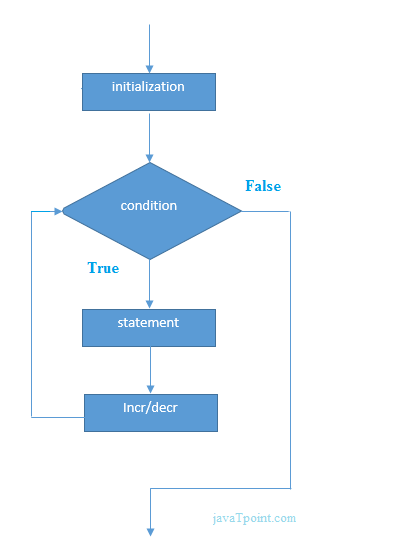
C for loop Examples
Let's see the simple program of for loop that prints table of 1.
- #include<stdio.h>
- Int main(){
- Int i=0;
- For(i=1;i<=10;i++){
- Printf("%d \n",i);
- }
- Return 0;
- }
Output
1
2
3
4
5
6
7
8
9
10
C Program: Print table for the given number using C for loop
- #include<stdio.h>
- Int main(){
- Int i=1,number=0;
- Printf("Enter a number: ");
- Scanf("%d",&number);
- For(i=1;i<=10;i++){
- Printf("%d \n",(number*i));
- }
- Return 0;
- }
Output
Enter a number: 2
2
4
6
8
10
12
14
16
18
20
Enter a number: 1000
1000
2000
3000
4000
5000
6000
7000
8000
9000
10000
Properties of Expression 1
- The expression represents the initialization of the loop variable.
- We can initialize more than one variable in Expression 1.
- Expression 1 is optional.
- In C, we can not declare the variables in Expression 1. However, It can be an exception in some compilers.
Example 1
- #include <stdio.h>
- Int main()
- {
- Int a,b,c;
- For(a=0,b=12,c=23;a<2;a++)
- {
- Printf("%d ",a+b+c);
- }
- }
Output
35 36
Example 2
- #include <stdio.h>
- Int main()
- {
- Int i=1;
- For(;i<5;i++)
- {
- Printf("%d ",i);
- }
- }
Output
1 2 3 4
Properties of Expression 2
- Expression 2 is a conditional expression. It checks for a specific condition to be satisfied. If it is not, the loop is terminated.
- Expression 2 can have more than one condition. However, the loop will iterate until the last condition becomes false. Other conditions will be treated as statements.
- Expression 2 is optional.
- Expression 2 can perform the task of expression 1 and expression 3. That is, we can initialize the variable as well as update the loop variable in expression 2 itself.
- We can pass zero or non-zero value in expression 2. However, in C, any non-zero value is true, and zero is false by default.
Example 1
- #include <stdio.h>
- Int main()
- {
- Int i;
- For(i=0;i<=4;i++)
- {
- Printf("%d ",i);
- }
- }
Output
0 1 2 3 4
Example 2
- #include <stdio.h>
- Int main()
- {
- Int i,j,k;
- For(i=0,j=0,k=0;i<4,k<8,j<10;i++)
- {
- Printf("%d %d %d\n",i,j,k);
- j+=2;
- k+=3;
- }
- }
Output
0 0 0
1 2 3
2 4 6
3 6 9
4 8 12
Example 3
- #include <stdio.h>
- Int main()
- {
- Int i;
- For(i=0;;i++)
- {
- Printf("%d",i);
- }
- }
Output
Infinite loop
Properties of Expression 3
- Expression 3 is used to update the loop variable.
- We can update more than one variable at the same time.
- Expression 3 is optional.
Example 1
- #include<stdio.h>
- Void main ()
- {
- Int i=0,j=2;
- For(i = 0;i<5;i++,j=j+2)
- {
- Printf("%d %d\n",i,j);
- }
- }
Output
0 2
1 4
2 6
3 8
4 10
Loop body
The braces {} are used to define the scope of the loop. However, if the loop contains only one statement, then we don't need to use braces. A loop without a body is possible. The braces work as a block separator, i.e., the value variable declared inside for loop is valid only for that block and not outside. Consider the following example.
- #include<stdio.h>
- Void main ()
- {
- Int i;
- For(i=0;i<10;i++)
- {
- Int i = 20;
- Printf("%d ",i);
- }
- }
Output
20 20 20 20 20 20 20 20 20 20
Infinitive for loop in C
To make a for loop infinite, we need not give any expression in the syntax. Instead of that, we need to provide two semicolons to validate the syntax of the for loop. This will work as an infinite for loop.
- #include<stdio.h>
- Void main ()
- {
- For(;;)
- {
- Printf("welcome to javatpoint");
- }
- }
If you run this program, you will see above statement infinite times.
Nested Loops in C
C supports nesting of loops in C. Nesting of loops is the feature in C that allows the looping of statements inside another loop. Let's observe an example of nesting loops in C.
Any number of loops can be defined inside another loop, i.e., there is no restriction for defining any number of loops. The nesting level can be defined at n times. You can define any type of loop inside another loop; for example, you can define 'while' loop inside a 'for' loop.
Syntax of Nested loop
- Outer_loop
- {
- Inner_loop
- {
- // inner loop statements.
- }
- // outer loop statements.
- }
Outer_loop and Inner_loop are the valid loops that can be a 'for' loop, 'while' loop or 'do-while' loop.
Nested for loop
The nested for loop means any type of loop which is defined inside the 'for' loop.
- For (initialization; condition; update)
- {
- For(initialization; condition; update)
- {
- // inner loop statements.
- }
- // outer loop statements.
- }
Example of nested for loop
- #include <stdio.h>
- Int main()
- {
- Int n;// variable declaration
- Printf("Enter the value of n :");
- // Displaying the n tables.
- For(int i=1;i<=n;i++) // outer loop
- {
- For(int j=1;j<=10;j++) // inner loop
- {
- Printf("%d\t",(i*j)); // printing the value.
- }
- Printf("\n");
- }
Explanation of the above code
- First, the 'i' variable is initialized to 1 and then program control passes to the i<=n.
- The program control checks whether the condition 'i<=n' is true or not.
- If the condition is true, then the program control passes to the inner loop.
- The inner loop will get executed until the condition is true.
- After the execution of the inner loop, the control moves back to the update of the outer loop, i.e., i++.
- After incrementing the value of the loop counter, the condition is checked again, i.e., i<=n.
- If the condition is true, then the inner loop will be executed again.
- This process will continue until the condition of the outer loop is true.
Output:

Nested while loop
The nested while loop means any type of loop which is defined inside the 'while' loop.
- While(condition)
- {
- While(condition)
- {
- // inner loop statements.
- }
- // outer loop statements.
- }
Example of nested while loop
- #include <stdio.h>
- Int main()
- {
- Int rows; // variable declaration
- Int columns; // variable declaration
- Int k=1; // variable initialization
- Printf("Enter the number of rows :"); // input the number of rows.
- Scanf("%d",&rows);
- Printf("\nEnter the number of columns :"); // input the number of columns.
- Scanf("%d",&columns);
- Int a[rows][columns]; //2d array declaration
- Int i=1;
- While(i<=rows) // outer loop
- {
- Int j=1;
- While(j<=columns) // inner loop
- {
- Printf("%d\t",k); // printing the value of k.
- k++; // increment counter
- j++;
- }
- i++;
- Printf("\n");
- }
- }
Explanation of the above code.
- We have created the 2d array, i.e., int a[rows][columns].
- The program initializes the 'i' variable by 1.
- Now, control moves to the while loop, and this loop checks whether the condition is true, then the program control moves to the inner loop.
- After the execution of the inner loop, the control moves to the update of the outer loop, i.e., i++.
- After incrementing the value of 'i', the condition (i<=rows) is checked.
- If the condition is true, the control then again moves to the inner loop.
- This process continues until the condition of the outer loop is true.
Output:

Nested do..while loop
The nested do..while loop means any type of loop which is defined inside the 'do..while' loop.
- Do
- {
- Do
- {
- // inner loop statements.
- }while(condition);
- // outer loop statements.
- }while(condition);
Example of nested do..while loop.
- #include <stdio.h>
- Int main()
- {
- /*printing the pattern
- ********
- ********
- ********
- ******** */
- Int i=1;
- Do // outer loop
- {
- Int j=1;
- Do // inner loop
- {
- Printf("*");
- j++;
- }while(j<=8);
- Printf("\n");
- i++;
- }while(i<=4);
- }
Output:
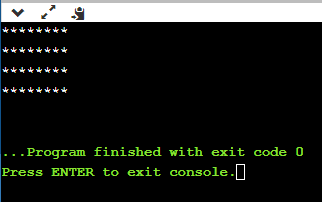
Explanation of the above code.
- First, we initialize the outer loop counter variable, i.e., 'i' by 1.
- As we know that the do..while loop executes once without checking the condition, so the inner loop is executed without checking the condition in the outer loop.
- After the execution of the inner loop, the control moves to the update of the i++.
- When the loop counter value is incremented, the condition is checked. If the condition in the outer loop is true, then the inner loop is executed.
- This process will continue until the condition in the outer loop is true.
Infinite Loop in C
What is infinite loop?
An infinite loop is a looping construct that does not terminate the loop and executes the loop forever. It is also called an indefinite loop or an endless loop. It either produces a continuous output or no output.
When to use an infinite loop
An infinite loop is useful for those applications that accept the user input and generate the output continuously until the user exits from the application manually. In the following situations, this type of loop can be used:
- All the operating systems run in an infinite loop as it does not exist after performing some task. It comes out of an infinite loop only when the user manually shuts down the system.
- All the servers run in an infinite loop as the server responds to all the client requests. It comes out of an indefinite loop only when the administrator shuts down the server manually.
- All the games also run in an infinite loop. The game will accept the user requests until the user exits from the game.
We can create an infinite loop through various loop structures. The following are the loop structures through which we will define the infinite loop:
- For loop
- While loop
- Do-while loop
- Go to statement
- C macros
For loop
Let's see the infinite 'for' loop. The following is the definition for the infinite for loop:
- For(; ;)
- {
- // body of the for loop.
- }
As we know that all the parts of the 'for' loop are optional, and in the above for loop, we have not mentioned any condition; so, this loop will execute infinite times.
Let's understand through an example.
- #include <stdio.h>
- Int main()
- {
- For(;;)
- {
- Printf("Hello javatpoint");
- }
- Return 0;
- }
In the above code, we run the 'for' loop infinite times, so "Hello javatpoint" will be displayed infinitely.
Output
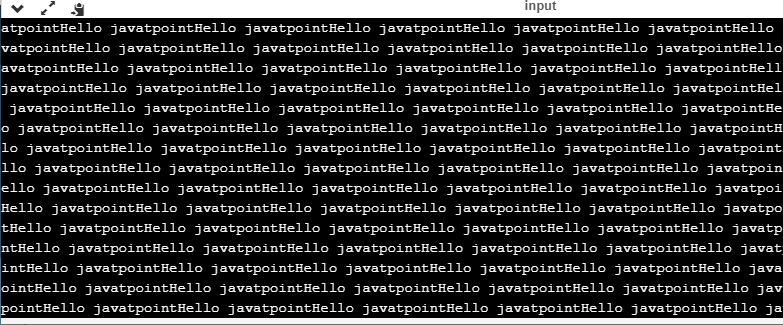
While loop
Now, we will see how to create an infinite loop using a while loop. The following is the definition for the infinite while loop:
- While(1)
- {
- // body of the loop..
- }
In the above while loop, we put '1' inside the loop condition. As we know that any non-zero integer represents the true condition while '0' represents the false condition.
Let's look at a simple example.
- #include <stdio.h>
- Int main()
- {
- Int i=0;
- While(1)
- {
- i++;
- Printf("i is :%d",i);
- }
- Return 0;
- }
In the above code, we have defined a while loop, which runs infinite times as it does not contain any condition. The value of 'i' will be updated an infinite number of times.
Output

Do..while loop
The do..while loop can also be used to create the infinite loop. The following is the syntax to create the infinite do..while loop.
- Do
- {
- // body of the loop..
- }while(1);
The above do..while loop represents the infinite condition as we provide the '1' value inside the loop condition. As we already know that non-zero integer represents the true condition, so this loop will run infinite times.
Goto statement
We can also use the goto statement to define the infinite loop.
- Infinite_loop;
- // body statements.
- Goto infinite_loop;
In the above code, the goto statement transfers the control to the infinite loop.
Macros
We can also create the infinite loop with the help of a macro constant. Let's understand through an example.
- #include <stdio.h>
- #define infinite for(;;)
- Int main()
- {
- Infinite
- {
- Printf("hello");
- }
- Return 0;
- }
In the above code, we have defined a macro named as 'infinite', and its value is 'for(;;)'. Whenever the word 'infinite' comes in a program then it will be replaced with a 'for(;;)'.
Output

Till now, we have seen various ways to define an infinite loop. However, we need some approach to come out of the infinite loop. In order to come out of the infinite loop, we can use the break statement.
Let's understand through an example.
- #include <stdio.h>
- Int main()
- {
- Char ch;
- While(1)
- {
- Ch=getchar();
- If(ch=='n')
- {
- Break;
- }
- Printf("hello");
- }
- Return 0;
- }
In the above code, we have defined the while loop, which will execute an infinite number of times until we press the key 'n'. We have added the 'if' statement inside the while loop. The 'if' statement contains the break keyword, and the break keyword brings control out of the loop.
Unintentional infinite loops
Sometimes the situation arises where unintentional infinite loops occur due to the bug in the code. If we are the beginners, then it becomes very difficult to trace them. Below are some measures to trace an unintentional infinite loop:
- We should examine the semicolons carefully. Sometimes we put the semicolon at the wrong place, which leads to the infinite loop.
- #include <stdio.h>
- Int main()
- {
- Int i=1;
- While(i<=10);
- {
- Printf("%d", i);
- i++;
- }
- Return 0;
- }
In the above code, we put the semicolon after the condition of the while loop which leads to the infinite loop. Due to this semicolon, the internal body of the while loop will not execute.
- We should check the logical conditions carefully. Sometimes by mistake, we place the assignment operator (=) instead of a relational operator (= =).
- #include <stdio.h>
- Int main()
- {
- Char ch='n';
- While(ch='y')
- {
- Printf("hello");
- }
- Return 0;
- }
In the above code, we use the assignment operator (ch='y') which leads to the execution of loop infinite number of times.
- We use the wrong loop condition which causes the loop to be executed indefinitely.
- #include <stdio.h>
- Int main()
- {
- For(int i=1;i>=1;i++)
- {
- Printf("hello");
- }
- Return 0;
- }
The above code will execute the 'for loop' infinite number of times. As we put the condition (i>=1), which will always be true for every condition, it means that "hello" will be printed infinitely.
- We should be careful when we are using the break keyword in the nested loop because it will terminate the execution of the nearest loop, not the entire loop.
- #include <stdio.h>
- Int main()
- {
- While(1)
- {
- For(int i=1;i<=10;i++)
- {
- If(i%2==0)
- {
- Break;
- }
- }
- }
- Return 0;
- }
In the above code, the while loop will be executed an infinite number of times as we use the break keyword in an inner loop. This break keyword will bring the control out of the inner loop, not from the outer loop.
- We should be very careful when we are using the floating-point value inside the loop as we cannot underestimate the floating-point errors.
- #include <stdio.h>
- Int main()
- {
- Float x = 3.0;
- While (x != 4.0) {
- Printf("x = %f\n", x);
- x += 0.1;
- }
- Return 0;
- }
In the above code, the loop will run infinite times as the computer represents a floating-point value as a real value. The computer will represent the value of 4.0 as 3.999999 or 4.000001, so the condition (x !=4.0) will never be false. The solution to this problem is to write the condition as (k<=4.0).
In conditional branching change in sequence of statement execution is depends upon the specified condition. Conditional statements allow programmer to check a condition and execute certain parts of code depending on the result of conditional expression. Conditional expression must be resulted into Boolean value. In C language, there are two forms of conditional statements:
1. If-----else statement: It is used to select one option between two alternatives
2. Switch statement: It is used to select one option between multiple alternative
- If Statements
This statement permits the programmer to allocate condition on the execution of a statement. If the evaluated condition found to be true, the single statement following the "if" is execute. If the condition is found to be false, the following statement is skipped. Syntax of the if statement is as follows
if (condition)
statement1;
statement2;
In the above syntax, “if” is the keyword and condition in parentheses must evaluate to true or false. If the condition is satisfied (true) then compiler will execute statement1 and then statement2. If the condition is not satisfied (false) then compiler will skip statement1 and directly execute statement2.
if-----else statement
This statement permits the programmer to execute a statement out of the two statements. If the evaluated condition is found to be true, the single statement following the "if" is executed and statement following else is skipped. If the condition is found to be false, statement following the "if" is skipped and statement following else is executed.
In this statement “if” part is compulsory whereas “else” is the optional part. For every “if” statement there may be or may not be “else” statement but for every “else” statement there must be “if” part otherwise compiler will gives “Misplaced else” error.
Syntax of the “if----else” statement is as follows
If (condition)
Statement1;
Else
Statement2;
In the above syntax, “if” and “else” are the keywords and condition in parentheses must evaluate to true or false. If the condition is satisfied (true) then compiler will execute statement1 and skip statement2. If the condition is not satisfied (false) then compiler will skip statement1 and directly execute statement2.
Nested if-----else statements :
Nested “if-----else” statements are used when programmer wants to check multiple conditions. Nested “if---else” contains several “if---else” a statement out of which only one statement is executed. Number of “if----else” statements is equal to the number of conditions to be checked. Following is the syntax for nested “if---else” statements for three conditions
If (condition1)
Statement1;
Else if (condition2)
Statement2;
Else if (condition3)
Statement3;
Else
Statement4;
In the above syntax, compiler first check condition1, if it trues then it will execute statement1 and skip all the remaining statements. If condition1 is false then compiler directly checks condition2, if it is true then compiler execute statement2 and skip all the remaining statements. If condition2 is also false then compiler directly checks condition3, if it is true then compiler execute statement3 otherwise it will execute statement 4.
Note:
If the test expression is evaluated to true,
• Statements inside the body of if are executed.
• Statements inside the body of else are skipped from execution.
If the test expression is evaluated to false,
• Statements inside the body of else are executed
• Statements inside the body of if are skipped from execution.
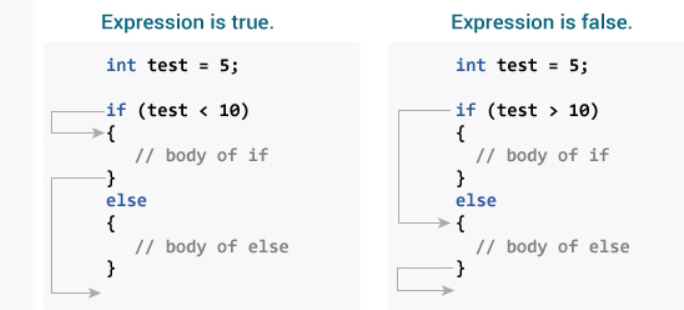
// Check whether an integer is odd or even
#include <stdio.h>
Int main() {
Int number;
Printf("Enter an integer: ");
Scanf("%d", &number);
// True if the remainder is 0
If (number%2 == 0) {
Printf("%d is an even integer.",number);
}
Else {
Printf("%d is an odd integer.",number);
}
Return 0;
}
Program to relate two integers using =, > or < symbol
#include <stdio.h>
Int main() {
Int number1, number2;
Printf("Enter two integers: ");
Scanf("%d %d", &number1, &number2);
//checks if the two integers are equal.
If(number1 == number2) {
Printf("Result: %d = %d",number1,number2);
}
//checks if number1 is greater than number2.
Else if (number1 > number2) {
Printf("Result: %d > %d", number1, number2);
}
//checks if both test expressions are false
Else {
Printf("Result: %d < %d",number1, number2);
}
Return 0;
}
- Switch Statements
This statement permits the programmer to choose one option out of several options depending on one condition. When the “switch” statement is executed, the expression in the switch statement is evaluated and the control is transferred directly to the group of statements whose “case” label value matches with the value of the expression. Syntax for switch statement is as follows:
Switch(expression)
{
Case constant1:
Statements 1;
Break;
Case constant2:
Statements 2;
Break;
…………………..
Default:
Statements n;
Break;
}
In the above, “switch”, “case”, “break” and “default” are keywords. Out of which “switch” and “case” are the compulsory keywords whereas “break” and “default” is optional keywords.
- “switch” keyword is used to start switch statement with conditional expression.
- “case” is the compulsory keyword which labeled with a constant value. If the value of expression matches with the case value then statement followed by “case” statement is executed.
- “break” is the optional keyword in switch statement. The execution of “break” statement causes the transfer of flow of execution outside the “switch” statements scope. Absence of “break” statement causes the execution of all the following “case” statements without concerning value of the expression.
- “default” is the optional keyword in “switch” statement. When the value of expression is not match with the any of the “case” statement then the statement following “default” keyword is executed.
Example: Program to spell user entered single digit number in English is as follows
#include<stdio.h>
#include<conio.h>
Void main()
{
Int n;
Clrscr();
Printf("Enter a number");
Scanf("%d",&n);
Switch(n)
{
Case 0: printf("\n Zero");
Break;
Case 1: printf("\n One");
Break;
Case 2: printf("\n Two");
Break;
Case 3: printf("\n Three");
Break;
Case 4: printf("\n Four");
Break;
Case 5: printf("\n Five");
Break;
Case 6: printf("\n Six");
Break;
Case 7: printf("\n Seven");
Break;
Case 8: printf("\n Eight");
Break;
Case 9: printf("\n Nine");
Break;
Default: printf("Given number is not single digit number");
}
Getch();
}
Output
Enter a number
5
Five
Loops are a form of iteration (recursion being the other form). Proper use of recursion depends on viewing the problem in a certain way to extract the recursion. Loop-based iteration is no different. They all come down to the same process.
- View the task as a sequence identical or nearly identical sub-tasks
- Figure out what changes each iteration (if anything)
- Express that change in programming terms
- Figure out when the program should stop performing the task
- Express that end condition as a conditional that asks - under what condition should the task continue repeating (not when should it stop)
While Loops
The while loop is the universal loop - all loops can be constructed using while loops. All other loops are created for specific circumstances.
While( condition ) BB; | 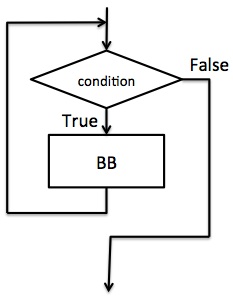 |
Int i = 0; While( i < 5 ) { Printf( "i = %d\n", i); i++; } Printf( "After loop, i = %d\n", i ); |  |
How it works:
The condition is checked prior to executing the body every time. It will only exit once the condition evaluates to false. Make sure you don't forget to have something change so that it eventually terminates the loop.
When to use this construct: This is appropriate for any loop - unless your loop follows the special circumstances for the loops below. In general, this is for loops for which the exit condition is not simply a counter that increments (as you see above). Instead, it's perfect for loops such as menus asking for user input.
Do-while
If you know you want to run the body of a loop at least once, then a do-while loop is appropriate.
Do{ BB; } while( condition ) | 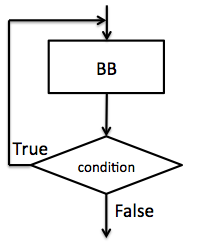 |
Int stop = 0; Do { Stop = Menu(); } while (!stop); |  |
How it works:
The BB will run once no matter what, then the condition will be evaluated. Once that BB is run once, it is equivalent to the while loop.
When to use this construct: When you want the body to run at least once.
For
The for loop was created based on a common mistake when implementing loops - forgetting the update step. That is, forgetting to increment your counter or some such action. If you forget the action that gets you closer to loop termination, then your loop will not terminate.
The for loop is designed so that
- Programmers will remember the lines that are crucial to loop termination
- Others reading the loop will be able to quickly read what controls the loop
For (init; condition; update) { BB; } | 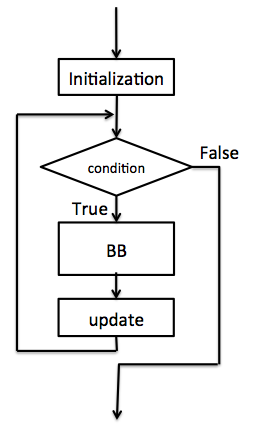 |
Int i; For( i = 0; i < 5; i++ ) Printf( "i = %d\n", i ); Printf( "After loop\n"); | 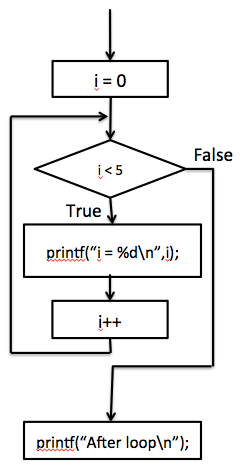 |
How it works:
The init code runs before the loop. Then it evaluates the condition. Next, it runs the loop body. It finishes with the update step, looping back to the condition again. The most common mistake in terms of understanding is forgetting that the condition is evaluated prior to the first loop iteration.
When to use this construct:
When your loop control is very simple and can be expressed easily inside the for loop syntax.
The comma operator
- C has a comma operator, that basically combines two statements so that they can be considered as a single statement.
- About the only place this is ever used is in for loops, to either provide multiple initializations or to allow for multiple incrementations.
- For example:
Int i, j = 10, sum;
For( i = 0, sum = 0; i < 5; i++, j-- )
Sum += i * j;
Break and continue
- Break and continue are two C/C++ statements that allow us to further control flow within and out of loops.
- Break causes execution to immediately jump out of the current loop, and proceed with the code following the loop.
- Continue causes the remainder of the current iteration of the loop to be skipped, and for execution to recommence with the next iteration.
- In the case of for loops, the incrementation step will be executed next, followed by the condition test to start the next loop iteration.
- In the case of while and do-while loops, execution jumps to the next loop condition test.
One dimensional Array
The variable allows us to store a single value at a time, what if we want to store roll no. Of 100 students? For this task, we have to declare 100 variables, then assign values to each of them. What if there are 10000 students or more? As you can see declaring that many variables for a single entity (i.e student) is not a good idea. In a situation like these arrays provide a better way to store data.
What is an Array?
An array is a collection of one or more values of the same type. Each value is called an element of the array. The elements of the array share the same variable name but each element has its own unique index number (also known as a subscript). An array can be of any type, For example: int, float, char etc. If an array is of type int then it's elements must be of type int only.
To store roll no. Of 100 students, we have to declare an array of size 100 i.e roll_no[100]. Here size of the array is 100 , so it is capable of storing 100 values. In C, index or subscript starts from 0, so roll_no[0] is the first element, roll_no[1] is the second element and so on. Note that the last element of the array will be at roll_no[99] not at roll_no[100] because the index starts at 0.
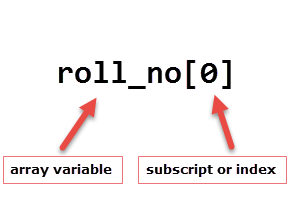
Arrays can be single or multidimensional. The number of subscript or index determines the dimensions of the array. An array of one dimension is known as a one-dimensional array or 1-D array, while an array of two dimensions is known as a two-dimensional array or 2-D array.
Let's start with a one-dimensional array.
One-dimensional array
Conceptually you can think of a one-dimensional array as a row, where elements are stored one after another.
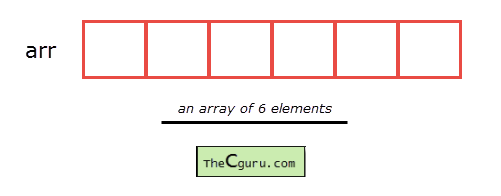
Syntax: datatype array_name[size];
Datatype: It denotes the type of the elements in the array.
Array_name: Name of the array. It must be a valid identifier.
Size: Number of elements an array can hold. Here are some example of array declarations:
1 2 3 | Int num[100]; Float temp[20]; Char ch[50]; |
Num is an array of type int, which can only store 100 elements of type int.
temp is an array of type float, which can only store 20 elements of type float.
ch is an array of type char, which can only store 50 elements of type char.
Note: When an array is declared it contains garbage values.
The individual elements in the array:
1 2 3 | Num[0], num[1], num[2], ....., num[99] Temp[0], temp[1], temp[2], ....., temp[19] Ch[0], ch[1], ch[2], ....., ch[49] |
We can also use variables and symbolic constants to specify the size of the array.
1 2 3 4 5 6 7 8 9 10 | #define SIZE 10
Int main() { Int size = 10;
Int my_arr1[SIZE]; // ok Int my_arr2[size]; // not allowed until C99 // ... } |
Note: Until C99 standard, we were not allowed to use variables to specify the size of the array. If you are using a compiler which supports C99 standard, the above code would compile successfully. However, If you're using an older version of C compiler like Turbo C++, then you will get an error.
The use of symbolic constants makes the program maintainable, because later if you want to change the size of the array you need to modify it at once place only i.e in the #define directive.
Accessing elements of an array
The elements of an array can be accessed by specifying array name followed by subscript or index inside square brackets (i.e []). Array subscript or index starts at 0. If the size of an array is 10 then the first element is at index 0, while the last element is at index 9. The first valid subscript (i.e 0) is known as the lower bound, while last valid subscript is known as the upper bound.
Int my_arr[5];
Then elements of this array are;
First element – my_arr[0]
Second element – my_arr[1]
Third element – my_arr[2]
Fourth element – my_arr[3]
Fifth element – my_arr[4]
Array subscript or index can be any expression that yields an integer value. For example:
1 2 3 4 | Int i = 0, j = 2; My_arr[i]; // 1st element My_arr[i+1]; // 2nd element My_arr[i+j]; // 3rd element |
In the array my_arr, the last element is at my_arr[4], What if you try to access elements beyond the last valid index of the array?
1 2 3 | Printf("%d", my_arr[5]); // 6th element Printf("%d", my_arr[10]); // 11th element Printf("%d", my_arr[-1]); // element just before 0 |
Sure indexes 5, 10 and -1 are not valid but C compiler will not show any error message instead some garbage value will be printed. The C language doesn't check bounds of the array. It is the responsibility of the programmer to check array bounds whenever required.
Processing 1-D arrays
The following program uses for loop to take input and print elements of a 1-D array.
1 2 3 4 5 6 7 8 9 10 11 12 13 14 15 16 17 18 19 20 21 22 | #include<stdio.h>
Int main() { Int arr[5], i;
For(i = 0; i < 5; i++) { Printf("Enter a[%d]: ", i); Scanf("%d", &arr[i]); }
Printf("\nPrinting elements of the array: \n\n");
For(i = 0; i < 5; i++) { Printf("%d ", arr[i]); }
// signal to operating system program ran fine Return 0; } |
Expected Output:
1 2 3 4 5 6 7 8 9 | Enter a[0]: 11 Enter a[1]: 22 Enter a[2]: 34 Enter a[3]: 4 Enter a[4]: 34
Printing elements of the array:
11 22 34 4 34 |
How it works:
In Line 5, we have declared an array of 5 integers and variable i of type int. Then a for loop is used to enter five elements into an array. In scanf() we have used & operator (also known as the address of operator) on element arr[i] of an array, just like we had done with variables of type int, float, char etc. Line 13 prints "Printing elements of the array" to the console. The second for loop prints all the elements of an array one by one.
The following program prints the sum of elements of an array.
1 2 3 4 5 6 7 8 9 10 11 12 13 14 15 16 17 18 19 20 21 22 | #include<stdio.h>
Int main() { Int arr[5], i, s = 0;
For(i = 0; i < 5; i++) { Printf("Enter a[%d]: ", i); Scanf("%d", &arr[i]); }
For(i = 0; i < 5; i++) { s += arr[i]; }
Printf("\nSum of elements = %d ", s);
// signal to operating system program ran fine Return 0; } |
Expected Output:
1 2 3 4 5 6 7 | Enter a[0]: 22 Enter a[1]: 33 Enter a[2]: 56 Enter a[3]: 73 Enter a[4]: 23
Sum of elements = 207 |
How it works: The first for loop asks the user to enter five elements into the array. The second for loop reads all the elements of an array one by one and accumulate the sum of all the elements in the variable s. Note that it is necessary to initialize the variable s to 0, otherwise, we will get the wrong answer because of the garbage value of s.
Initializing Array
When an array is declared inside a function the elements of the array have garbage value. If an array is global or static, then its elements are automatically initialized to 0. We can explicitly initialize elements of an array at the time of declaration using the following syntax:
Syntax: datatype array_name[size] = { val1, val2, val3, ..... ValN };
Datatype is the type of elements of an array.
Array_name is the variable name, which must be any valid identifier.
Size is the size of the array.
Val1, val2 ... Are the constants known as initializers. Each value is separated by a comma(,) and then there is a semi-colon (;) after the closing curly brace (}).
Here is are some examples:
1 2 3 | Float temp[5] = {12.3, 4.1, 3.8, 9.5, 4.5}; // an array of 5 floats
Int arr[9] = {11, 22, 33, 44, 55, 66, 77, 88, 99}; // an array of 9 ints |
While initializing 1-D array it is optional to specify the size of the array, so you can also write the above statements as:
1 2 3 | Float temp[] = {12.3, 4.1, 3.8, 9.5, 4.5}; // an array of 5 floats
Int arr[] = {11, 22, 33, 44, 55, 66, 77, 88, 99}; // an array of 9 ints |
If the number of initializers is less than the specified size then the remaining elements of the array are assigned a value of 0.
Float temp[5] = {12.3, 4.1};
Here the size of temp array is 5 but there are only two initializers. After this initialization the elements of the array are as follows:
Temp[0] is 12.3
temp[1] is 4.1
temp[2] is 0
temp[3] is 0
temp[4] is 0
If the number of initializers is greater than the size of the array then, the compiler will report an error. For example:
Int num[5] = {1, 2, 3, 4, 5, 6, 7, 8} // error
The following program finds the highest and lowest elements in an array.
1 2 3 4 5 6 7 8 9 10 11 12 13 14 15 16 17 18 19 20 21 22 23 24 25 26 27 28 29 30 31 32 33 | #include<stdio.h> #define SIZE 10
Int main() { Int my_arr[SIZE] = {34,56,78,15,43,71,89,34,70,91}; Int i, max, min;
Max = min = my_arr[0];
For(i = 0; i < SIZE; i++) { // if value of current element is greater than previous value // then assign new value to max If(my_arr[i] > max) { Max = my_arr[i]; }
// if the value of current element is less than previous element // then assign new value to min If(my_arr[i] < min) { Min = my_arr[i]; } }
Printf("Lowest value = %d\n", min); Printf("Highest value = %d", max);
// signal to operating system everything works fine Return 0; } |
Expected Output:
1 2 | Lowest value = 15 Highest value = 91 |
How it works: In line 6, first, we have declared and initialized an array of 10 integers. In the next line, we have declared three more variables of type int namely: i, max and min. In line 9, we have assigned the value of the first element of my_arr to max and min. A for loop is used to iterate through all the elements of an array. Inside the for loop, the first if condition (my_arr[i] > max) checks whether the current element is greater than max, if it is, we assign the value of the current element to max.
The second if statement checks whether the value of the current element is smaller than the value of min. If it is, we assign the value of the current element to min. This process continues until there are elements in the array left to iterate.
When the process is finished, max and min variables will have maximum and minimum values respectively.
Two dimensional Array
The two-dimensional array can be defined as an array of arrays. The 2D array is organized as matrices which can be represented as the collection of rows and columns. However, 2D arrays are created to implement a relational database lookalike data structure. It provides ease of holding the bulk of data at once which can be passed to any number of functions wherever required.
Declaration of two dimensional Array in C
The syntax to declare the 2D array is given below.
- Data_type array_name[rows][columns];
Consider the following example.
- Int twodimen[4][3];
Here, 4 is the number of rows, and 3 is the number of columns.
Initialization of 2D Array in C
In the 1D array, we don't need to specify the size of the array if the declaration and initialization are being done simultaneously. However, this will not work with 2D arrays. We will have to define at least the second dimension of the array. The two-dimensional array can be declared and defined in the following way.
- Int arr[4][3]={{1,2,3},{2,3,4},{3,4,5},{4,5,6}};
Two-dimensional array example in C
- #include<stdio.h>
- Int main(){
- Int i=0,j=0;
- Int arr[4][3]={{1,2,3},{2,3,4},{3,4,5},{4,5,6}};
- //traversing 2D array
- For(i=0;i<4;i++){
- For(j=0;j<3;j++){
- Printf("arr[%d] [%d] = %d \n",i,j,arr[i][j]);
- }//end of j
- }//end of i
- Return 0;
- }
Output
Arr[0][0] = 1
Arr[0][1] = 2
Arr[0][2] = 3
Arr[1][0] = 2
Arr[1][1] = 3
Arr[1][2] = 4
Arr[2][0] = 3
Arr[2][1] = 4
Arr[2][2] = 5
Arr[3][0] = 4
Arr[3][1] = 5
Arr[3][2] = 6
C 2D array example: Storing elements in a matrix and printing it.
- #include <stdio.h>
- Void main ()
- {
- Int arr[3][3],i,j;
- For (i=0;i<3;i++)
- {
- For (j=0;j<3;j++)
- {
- Printf("Enter a[%d][%d]: ",i,j);
- Scanf("%d",&arr[i][j]);
- }
- }
- Printf("\n printing the elements ....\n");
- For(i=0;i<3;i++)
- {
- Printf("\n");
- For (j=0;j<3;j++)
- {
- Printf("%d\t",arr[i][j]);
- }
- }
- }
Output
Enter a[0][0]: 56
Enter a[0][1]: 10
Enter a[0][2]: 30
Enter a[1][0]: 34
Enter a[1][1]: 21
Enter a[1][2]: 34
Enter a[2][0]: 45
Enter a[2][1]: 56
Enter a[2][2]: 78
Printing the elements ....
56 10 30
34 21 34
45 56 78
A string is a collection of characters, stored in an array followed by null ('\0') character. Null character represents the end of string.
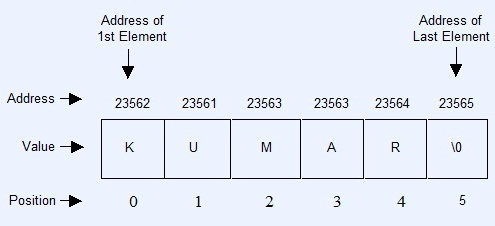
Address of first element is random, address of next element depend upon the type of array. Here, the type is character and character takes one byte in memory, therefore every next address will increment by one.
Index of array will always starts with zero.
Declaration of String or Character array
Declaration of array means creating sequential bolcks of memory to hold fixed number of values.
Syntax for string declaration :
Char String-name[size of String ];
Example for string declaration :
Char String [25]; //Statement 1
In the above example we have declared a character array which can hold twenty-five characters at a time.
Initialization of String
Initialization of string means assigning value to declared character array or string.
Examples 1 :Using sequence of characters.
Char String [ ] = {'H','e','l','l','o',' ','W','o','r','l','d','\0'};
In the above example, we are declaring and initializing a string at same time. When we declare and initialize a string at same time, giving the size of array is optional and it is programmer's job to specify the null character at the end to terminate the string.
Example 2 : Using assignment operator
Char String [ ] = "Hello World";
In this approch, programmer doesn't need to provide null character, compiler will automatically add null character at the end of string.
Input string using getche() function
The getche() read characters from console (output window) one by one and put these characters into string using loop.
Examples for input string with getche() function
#include<stdio.h>
Void main()
{
Char String [50];
Char ch;
Int i;
Printf("\n\n\tEnter your name : ");
For(i=0;i<50;i++)
{
Ch = getche(); //Statement 1
If(ch==13) //Statement 2
Break;
String [i] = ch;
}
String [i] = '\0'; //Statement 3
Printf("\n\n\tHello, ");
For(i=0; String [i]!='\0';i++)
Printf("%c", String [i]);
}
Output :
Enter your name : Kumar
Hello Kumar
In the above example, A for loop will execute upto 50 time and getche() which inside for loop will read single character from console and put the character into ch. If user press the enter key, condition given in statement 2 will satisfy and terminate the loop otherwise every character will assign to String. Statement 4 is assigning null character to String.
Input string using scanf() function
The scanf() can read the entire word at a time. The format specifier for a string is "%s". The scanf() ignores the any occurrence of leading whitespace characters and terminate the string at the first occurrence of whitespace after any input.
Examples for input string with scanf() function
#include<stdio.h>
Void main()
{
Char String [50];
Printf("\n\n\tEnter your name : ");
Scanf("%s", String );
Printf("\n\n\tHello %s", String );
}
Output :
Enter your name : Kumar Wadhwa
Hello Kumar
In the output of above example there is five leading whitespaces in the input which is ignored by the compiler.
Input string using gets() function
The gets() can read the entire line at a time and the string will not terminate until user press the enter key. The gets() will put all the leading and trailing whitespaces into str.
Examples for input string with gets() function
#include<stdio.h>
Void main()
{
Char String [50];
Printf("\n\n\tEnter your name : ");
Gets( String );
Printf("\n\n\tHello %s", String );
}
Output :
Enter your name : Kumar Wadhwa
Hello Kumar Wadhwa
In the output of above example there is five leading whitespaces in the input which is not ignored by the compiler.
Searching
Searching is the process of finding some particular element in the list. If the element is present in the list, then the process is called successful and the process returns the location of that element, otherwise the search is called unsuccessful.
There are two popular search methods that are widely used in order to search some item into the list. However, choice of the algorithm depends upon the arrangement of the list.
- Linear Search
- Binary Search
Linear Search
Linear search is the simplest search algorithm and often called sequential search. In this type of searching, we simply traverse the list completely and match each element of the list with the item whose location is to be found. If the match found then location of the item is returned otherwise the algorithm return NULL.
Linear search is mostly used to search an unordered list in which the items are not sorted. The algorithm of linear search is given as follows.
Algorithm
- LINEAR_SEARCH(A, N, VAL)
- Step 1: [INITIALIZE] SET POS = -1
- Step 2: [INITIALIZE] SET I = 1
- Step 3: Repeat Step 4 while I<=N
- Step 4: IF A[I] = VAL
SET POS = I
PRINT POS
Go to Step 6
[END OF IF]
SET I = I + 1
[END OF LOOP] - Step 5: IF POS = -1
PRINT " VALUE IS NOT PRESENTIN THE ARRAY "
[END OF IF] - Step 6: EXIT
Complexity of algorithm
Complexity | Best Case | Average Case | Worst Case |
Time | O(1) | O(n) | O(n) |
Space |
|
| O(1) |
C Program
- #include<stdio.h>
- Void main ()
- {
- Int a[10] = {10, 23, 40, 1, 2, 0, 14, 13, 50, 9};
- Int item, i,flag;
- Printf("\nEnter Item which is to be searched\n");
- Scanf("%d",&item);
- For (i = 0; i< 10; i++)
- {
- If(a[i] == item)
- {
- Flag = i+1;
- Break;
- }
- Else
- Flag = 0;
- }
- If(flag != 0)
- {
- Printf("\nItem found at location %d\n",flag);
- }
- Else
- {
- Printf("\nItem not found\n");
- }
- }
Output:
Enter Item which is to be searched
20
Item not found
Enter Item which is to be searched
23
Item found at location 2
Java Program
- Import java.util.Scanner;
- Public class Leniear_Search {
- Public static void main(String[] args) {
- Int[] arr = {10, 23, 15, 8, 4, 3, 25, 30, 34, 2, 19};
- Int item,flag=0;
- Scanner sc = new Scanner(System.in);
- System.out.println("Enter Item ?");
- Item = sc.nextInt();
- For(int i = 0; i<10; i++)
- {
- If(arr[i]==item)
- {
- Flag = i+1;
- Break;
- }
- Else
- Flag = 0;
- }
- If(flag != 0)
- {
- System.out.println("Item found at location" + flag);
- }
- Else
- System.out.println("Item not found");
- }
- }
Output:
Enter Item ?
23
Item found at location 2
Enter Item ?
22
Item not found
C# Program
- Using System;
- Public class LinearSearch
- {
- Public static void Main()
- {
- Int item, flag = 0;
- Int[] a= {10, 23, 5, 90, 89, 34, 12, 34, 1, 78};
- Console.WriteLine("Enter the item value");
- Item = Convert.ToInt32(Console.ReadLine());
- For(int i=0;i<10;i++)
- {
- If(item == a[i])
- {
- Flag = i+1;
- Break;
- }
- Else
- Flag = 0;
- }
- If(flag != 0 )
- {
- Console.WriteLine("Item Found at Location " + flag);
- }
- Else
- Console.WriteLine("Item Not Found");
- }
- }
Output:
Enter the item value
78
Item Found at Location 10
Enter the item value
22
Item not found
Python Program
- Arr = [10,2,3,4,23,5,21,45,90,100];
- Item = int(input("Enter the item which you want to search "));
- For i in range (0,len(arr)):
- If arr[i] == item:
- Flag = i+1;
- Break;
- Else:
- Flag = 0;
- If flag != 0:
- Print("Item found at location %d" % (flag));
- Else :
- Print("Item not found");
Output:
Enter the item which you want to search 2
Item found at location 2
Enter the item which you want to search 101
Item not found
Binary Search
Binary search is the search technique which works efficiently on the sorted lists. Hence, in order to search an element into some list by using binary search technique, we must ensure that the list is sorted.
Binary search follows divide and conquer approach in which, the list is divided into two halves and the item is compared with the middle element of the list. If the match is found then, the location of middle element is returned otherwise, we search into either of the halves depending upon the result produced through the match.
Binary search algorithm is given below.
BINARY_SEARCH(A, lower_bound, upper_bound, VAL)
- Step 1: [INITIALIZE] SET BEG = lower_bound
END = upper_bound, POS = - 1 - Step 2: Repeat Steps 3 and 4 while BEG <=END
- Step 3: SET MID = (BEG + END)/2
- Step 4: IF A[MID] = VAL
SET POS = MID
PRINT POS
Go to Step 6
ELSE IF A[MID] > VAL
SET END = MID - 1
ELSE
SET BEG = MID + 1
[END OF IF]
[END OF LOOP] - Step 5: IF POS = -1
PRINT "VALUE IS NOT PRESENT IN THE ARRAY"
[END OF IF] - Step 6: EXIT
Complexity
SN | Performance | Complexity |
1 | Worst case | O(log n) |
2 | Best case | O(1) |
3 | Average Case | O(log n) |
4 | Worst case space complexity | O(1) |
Example
Let us consider an array arr = {1, 5, 7, 8, 13, 19, 20, 23, 29}. Find the location of the item 23 in the array.
In 1st step :
- BEG = 0
- END = 8ron
- MID = 4
- a[mid] = a[4] = 13 < 23, therefore
In Second step:
- Beg = mid +1 = 5
- End = 8
- Mid = 13/2 = 6
- a[mid] = a[6] = 20 < 23, therefore;
In third step:
- Beg = mid + 1 = 7
- End = 8
- Mid = 15/2 = 7
- a[mid] = a[7]
- a[7] = 23 = item;
- Therefore, set location = mid;
- The location of the item will be 7.
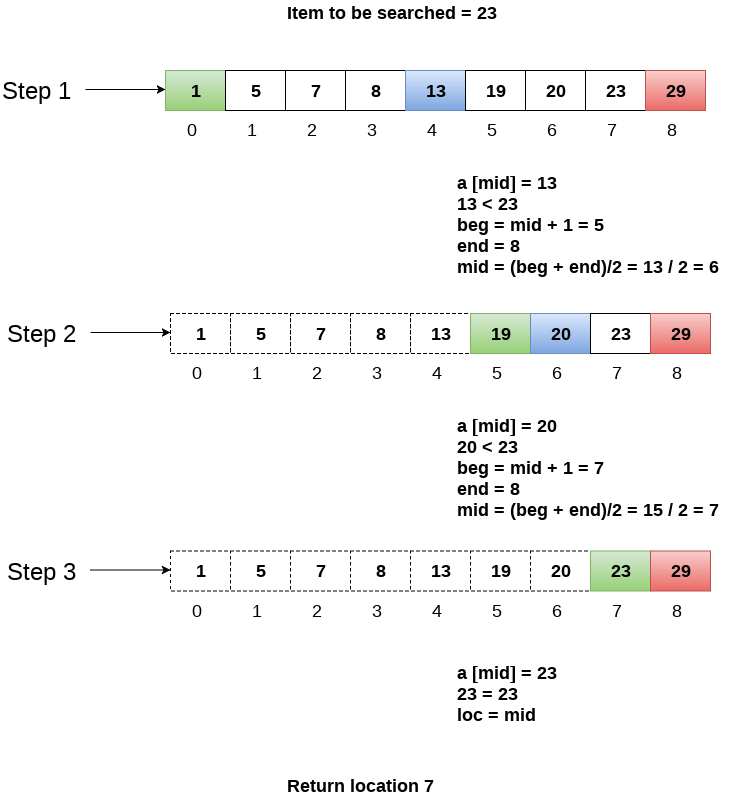
Binary Search Program using Recursion
C program
- #include<stdio.h>
- Int binarySearch(int[], int, int, int);
- Void main ()
- {
- Int arr[10] = {16, 19, 20, 23, 45, 56, 78, 90, 96, 100};
- Int item, location=-1;
- Printf("Enter the item which you want to search ");
- Scanf("%d",&item);
- Location = binarySearch(arr, 0, 9, item);
- If(location != -1)
- {
- Printf("Item found at location %d",location);
- }
- Else
- {
- Printf("Item not found");
- }
- }
- Int binarySearch(int a[], int beg, int end, int item)
- {
- Int mid;
- If(end >= beg)
- {
- Mid = (beg + end)/2;
- If(a[mid] == item)
- {
- Return mid+1;
- }
- Else if(a[mid] < item)
- {
- Return binarySearch(a,mid+1,end,item);
- }
- Else
- {
- Return binarySearch(a,beg,mid-1,item);
- }
- }
- Return -1;
- }
Output:
Enter the item which you want to search
19
Item found at location 2
Java
- Import java.util.*;
- Public class BinarySearch {
- Public static void main(String[] args) {
- Int[] arr = {16, 19, 20, 23, 45, 56, 78, 90, 96, 100};
- Int item, location = -1;
- System.out.println("Enter the item which you want to search");
- Scanner sc = new Scanner(System.in);
- Item = sc.nextInt();
- Location = binarySearch(arr,0,9,item);
- If(location != -1)
- System.out.println("the location of the item is "+location);
- Else
- System.out.println("Item not found");
- }
- Public static int binarySearch(int[] a, int beg, int end, int item)
- {
- Int mid;
- If(end >= beg)
- {
- Mid = (beg + end)/2;
- If(a[mid] == item)
- {
- Return mid+1;
- }
- Else if(a[mid] < item)
- {
- Return binarySearch(a,mid+1,end,item);
- }
- Else
- {
- Return binarySearch(a,beg,mid-1,item);
- }
- }
- Return -1;
- }
- }
Output:
Enter the item which you want to search
45
The location of the item is 5
C#
- Using System;
- Public class LinearSearch
- {
- Public static void Main()
- {
- Int[] arr = {16, 19, 20, 23, 45, 56, 78, 90, 96, 100};
- Int location=-1;
- Console.WriteLine("Enter the item which you want to search ");
- Int item = Convert.ToInt32(Console.ReadLine());
- Location = binarySearch(arr, 0, 9, item);
- If(location != -1)
- {
- Console.WriteLine("Item found at location "+ location);
- }
- Else
- {
- Console.WriteLine("Item not found");
- }
- }
- Public static int binarySearch(int[] a, int beg, int end, int item)
- {
- Int mid;
- If(end >= beg)
- {
- Mid = (beg + end)/2;
- If(a[mid] == item)
- {
- Return mid+1;
- }
- Else if(a[mid] < item)
- {
- Return binarySearch(a,mid+1,end,item);
- }
- Else
- {
- Return binarySearch(a,beg,mid-1,item);
- }
- }
- Return -1;
- }
- }
Output:
Enter the item which you want to search
20
Item found at location 3
Python
- Def binarySearch(arr,beg,end,item):
- If end >= beg:
- Mid = int((beg+end)/2)
- If arr[mid] == item :
- Return mid+1
- Elif arr[mid] < item :
- Return binarySearch(arr,mid+1,end,item)
- Else:
- Return binarySearch(arr,beg,mid-1,item)
- Return -1
- Arr=[16, 19, 20, 23, 45, 56, 78, 90, 96, 100];
- Item = int(input("Enter the item which you want to search ?"))
- Location = -1;
- Location = binarySearch(arr,0,9,item);
- If location != -1:
- Print("Item found at location %d" %(location))
- Else:
- Print("Item not found")
Output:
Enter the item which you want to search ?
96
Item found at location 9
Enter the item which you want to search ?
101
Item not found
Binary Search function using Iteration
- Int binarySearch(int a[], int beg, int end, int item)
- {
- Int mid;
- While(end >= beg)
- {
- Mid = (beg + end)/2;
- If(a[mid] == item)
- {
- Return mid+1;
- }
- Else if(a[mid] < item)
- {
- Beg = mid + 1;
- }
- Else
- {
- End = mid - 1;
- }
- }
- Return -1;
- }
Bubble Sort
In Bubble sort, Each element of the array is compared with its adjacent element. The algorithm processes the list in passes. A list with n elements requires n-1 passes for sorting. Consider an array A of n elements whose elements are to be sorted by using Bubble sort. The algorithm processes like following.
- In Pass 1, A[0] is compared with A[1], A[1] is compared with A[2], A[2] is compared with A[3] and so on. At the end of pass 1, the largest element of the list is placed at the highest index of the list.
- In Pass 2, A[0] is compared with A[1], A[1] is compared with A[2] and so on. At the end of Pass 2 the second largest element of the list is placed at the second highest index of the list.
- In pass n-1, A[0] is compared with A[1], A[1] is compared with A[2] and so on. At the end of this pass. The smallest element of the list is placed at the first index of the list.
Algorithm :
- Step 1: Repeat Step 2 For i = 0 to N-1
- Step 2: Repeat For J = i + 1 to N - I
- Step 3: IF A[J] > A[i]
SWAP A[J] and A[i]
[END OF INNER LOOP]
[END OF OUTER LOOP - Step 4: EXIT
Complexity
Scenario | Complexity |
Space | O(1) |
Worst case running time | O(n2) |
Average case running time | O(n) |
Best case running time | O(n2) |
C Program
- #include<stdio.h>
- Void main ()
- {
- Int i, j,temp;
- Int a[10] = { 10, 9, 7, 101, 23, 44, 12, 78, 34, 23};
- For(i = 0; i<10; i++)
- {
- For(j = i+1; j<10; j++)
- {
- If(a[j] > a[i])
- {
- Temp = a[i];
- a[i] = a[j];
- a[j] = temp;
- }
- }
- }
- Printf("Printing Sorted Element List ...\n");
- For(i = 0; i<10; i++)
- {
- Printf("%d\n",a[i]);
- }
- }
Output:
Printing Sorted Element List . . .
7
9
10
12
23
34
34
44
78
101
C++ Program
- #include<iostream>
- Using namespace std;
- Int main ()
- {
- Int i, j,temp;
- Int a[10] = { 10, 9, 7, 101, 23, 44, 12, 78, 34, 23};
- For(i = 0; i<10; i++)
- {
- For(j = i+1; j<10; j++)
- {
- If(a[j] < a[i])
- {
- Temp = a[i];
- a[i] = a[j];
- a[j] = temp;
- }
- }
- }
- Cout <<"Printing Sorted Element List ...\n";
- For(i = 0; i<10; i++)
- {
- Cout <<a[i]<<"\n";
- }
- Return 0;
- }
Output:
Printing Sorted Element List ...
7
9
10
12
23
23
34
44
78
101
Java Program
- Public class BubbleSort {
- Public static void main(String[] args) {
- Int[] a = {10, 9, 7, 101, 23, 44, 12, 78, 34, 23};
- For(int i=0;i<10;i++)
- {
- For (int j=0;j<10;j++)
- {
- If(a[i]<a[j])
- {
- Int temp = a[i];
- a[i]=a[j];
- a[j] = temp;
- }
- }
- }
- System.out.println("Printing Sorted List ...");
- For(int i=0;i<10;i++)
- {
- System.out.println(a[i]);
- }
- }
- }
Output:
Printing Sorted List . . .
7
9
10
12
23
34
34
44
78
101
C# Program
- Using System;
- Public class Program
- {
- Public static void Main()
- {
- Int i, j,temp;
- Int[] a = {10, 9, 7, 101, 23, 44, 12, 78, 34, 23};
- For(i = 0; i<10; i++)
- {
- For(j = i+1; j<10; j++)
- {
- If(a[j] > a[i])
- {
- Temp = a[i];
- a[i] = a[j];
- a[j] = temp;
- }
- }
- }
- Console.WriteLine("Printing Sorted Element List ...\n");
- For(i = 0; i<10; i++)
- {
- Console.WriteLine(a[i]);
- }
- }
- }
Output:
Printing Sorted Element List . . .
7
9
10
12
23
34
34
44
78
101
Python Program
- a=[10, 9, 7, 101, 23, 44, 12, 78, 34, 23]
- For i in range(0,len(a)):
- For j in range(i+1,len(a)):
- If a[j]<a[i]:
- Temp = a[j]
- a[j]=a[i]
- a[i]=temp
- Print("Printing Sorted Element List...")
- For i in a:
- Print(i)
Output:
Printing Sorted Element List . . .
7
9
10
12
23
34
34
44
78
101
Rust Program
- Fn main()
- {
- Let mut temp;
- Let mut a: [i32; 10] = [10, 9, 7, 101, 23, 44, 12, 78, 34, 23];
- For i in 0..10
- {
- For j in (i+1)..10
- {
- If a[j] < a[i]
- {
- Temp = a[i];
- a[i] = a[j];
- a[j] = temp;
- }
- }
- }
- Println!("Printing Sorted Element List ...\n");
- For i in &a
- {
- Println!("{} ",i);
- }
- }
Output:
Printing Sorted Element List . . .
7
9
10
12
23
34
34
44
78
101
4
JavaScript Program
- <html>
- <head>
- <title>
- Bubble Sort
- </title>
- </head>
- <body>
- <script>
- Var a = [10, 9, 7, 101, 23, 44, 12, 78, 34, 23];
- For(i=0;i<10;i++)
- {
- For (j=0;j<10;j++)
- {
- If(a[i]<a[j])
- {
- Temp = a[i];
- a[i]=a[j];
- a[j] = temp;
- }
- }
- }
- Txt = "<br>";
- Document.writeln("Printing Sorted Element List ..."+txt);
- For(i=0;i<10;i++)
- {
- Document.writeln(a[i]);
- Document.writeln(txt);
- }
- </script>
- </body>
- </html>
Output:
Printing Sorted Element List ...
7
9
10
12
23
23
34
44
78
101
PHP Program
- <html>
- <head>
- <title>Bubble Sort</title>
- </head>
- <body>
- <?php
- $a = array(10, 9, 7, 101, 23, 44, 12, 78, 34, 23);
- For($i=0;$i<10;$i++)
- {
- For ($j=0;$j<10;$j++)
- {
- If($a[$i]<$a[$j])
- {
- $temp = $a[$i];
- $a[$i]=$a[$j];
- $a[$j] = $temp;
- }
- }
- }
- Echo "Printing Sorted Element List ...\n";
- For($i=0;$i<10;$i++)
- {
- Echo $a[$i];
- Echo "\n";
- }
- ?>
- </body>
- </html>
Output:
Printing Sorted Element List ...
7
9
10
12
23
23
34
44
78
101
Selection Sort
Selection sort is a simple sorting algorithm. This sorting algorithm is an in-place comparison-based algorithm in which the list is divided into two parts, the sorted part at the left end and the unsorted part at the right end. Initially, the sorted part is empty and the unsorted part is the entire list.
The smallest element is selected from the unsorted array and swapped with the leftmost element, and that element becomes a part of the sorted array. This process continues moving unsorted array boundary by one element to the right.
This algorithm is not suitable for large data sets as its average and worst case complexities are of Ο(n2), where n is the number of items.
How Selection Sort Works?
Consider the following depicted array as an example.

For the first position in the sorted list, the whole list is scanned sequentially. The first position where 14 is stored presently, we search the whole list and find that 10 is the lowest value.

So we replace 14 with 10. After one iteration 10, which happens to be the minimum value in the list, appears in the first position of the sorted list.

For the second position, where 33 is residing, we start scanning the rest of the list in a linear manner.

We find that 14 is the second lowest value in the list and it should appear at the second place. We swap these values.

After two iterations, two least values are positioned at the beginning in a sorted manner.

The same process is applied to the rest of the items in the array.
Following is a pictorial depiction of the entire sorting process −
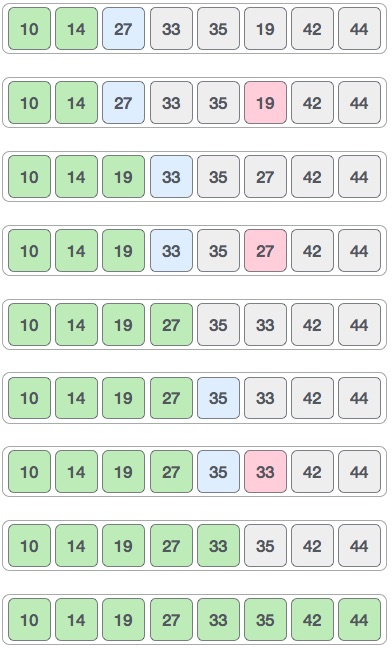
Now, let us learn some programming aspects of selection sort.
Algorithm
Step 1 − Set MIN to location 0
Step 2 − Search the minimum element in the list
Step 3 − Swap with value at location MIN
Step 4 − Increment MIN to point to next element
Step 5 − Repeat until list is sorted
Pseudocode
Procedure selection sort
List : array of items
n : size of list
For i = 1 to n - 1
/* set current element as minimum*/
Min = i
/* check the element to be minimum */
For j = i+1 to n
If list[j] < list[min] then
Min = j;
End if
End for
/* swap the minimum element with the current element*/
If indexMin != i then
Swap list[min] and list[i]
End if
End for
End procedure
Selection Sort Program
Selection sort is a simple sorting algorithm. This sorting algorithm is an in-place comparison-based algorithm in which the list is divided into two parts, the sorted part at the left end and the unsorted part at the right end. Initially, the sorted part is empty and the unsorted part is the entire list.
Implementation in C
#include <stdio.h>
#include <stdbool.h>
#define MAX 7
Int intArray[MAX] = {4,6,3,2,1,9,7};
Void printline(int count) {
Int i;
For(i = 0;i < count-1;i++) {
Printf("=");
}
Printf("=\n");
}
Void display() {
Int i;
Printf("[");
// navigate through all items
For(i = 0;i < MAX;i++) {
Printf("%d ", intArray[i]);
}
Printf("]\n");
}
Void selectionSort() {
Int indexMin,i,j;
// loop through all numbers
For(i = 0; i < MAX-1; i++) {
// set current element as minimum
IndexMin = i;
// check the element to be minimum
For(j = i+1;j < MAX;j++) {
If(intArray[j] < intArray[indexMin]) {
IndexMin = j;
}
}
If(indexMin != i) {
Printf("Items swapped: [ %d, %d ]\n" , intArray[i], intArray[indexMin]);
// swap the numbers
Int temp = intArray[indexMin];
IntArray[indexMin] = intArray[i];
IntArray[i] = temp;
}
Printf("Iteration %d#:",(i+1));
Display();
}
}
Void main() {
Printf("Input Array: ");
Display();
Printline(50);
SelectionSort();
Printf("Output Array: ");
Display();
Printline(50);
}
If we compile and run the above program, it will produce the following result −
Output
Input Array: [4 6 3 2 1 9 7 ]
==================================================
Items swapped: [ 4, 1 ]
Iteration 1#:[1 6 3 2 4 9 7 ]
Items swapped: [ 6, 2 ]
Iteration 2#:[1 2 3 6 4 9 7 ]
Iteration 3#:[1 2 3 6 4 9 7 ]
Items swapped: [ 6, 4 ]
Iteration 4#:[1 2 3 4 6 9 7 ]
Iteration 5#:[1 2 3 4 6 9 7 ]
Items swapped: [ 9, 7 ]
Iteration 6#:[1 2 3 4 6 7 9 ]
Output Array: [1 2 3 4 6 7 9 ]
==================================================
Insertion Sort
This is an in-place comparison-based sorting algorithm. Here, a sub-list is maintained which is always sorted. For example, the lower part of an array is maintained to be sorted. An element which is to be 'insert'ed in this sorted sub-list, has to find its appropriate place and then it is to be inserted there. Hence the name insertion sort.
Implementation in C
#include <stdio.h>
#include <stdbool.h>
#define MAX 7
Int intArray[MAX] = {4,6,3,2,1,9,7};
Void printline(int count) {
Int i;
For(i = 0;i < count-1;i++) {
Printf("=");
}
Printf("=\n");
}
Void display() {
Int i;
Printf("[");
// navigate through all items
For(i = 0;i < MAX;i++) {
Printf("%d ",intArray[i]);
}
Printf("]\n");
}
Void insertionSort() {
Int valueToInsert;
Int holePosition;
Int i;
// loop through all numbers
For(i = 1; i < MAX; i++) {
// select a value to be inserted.
ValueToInsert = intArray[i];
// select the hole position where number is to be inserted
HolePosition = i;
// check if previous no. Is larger than value to be inserted
While (holePosition > 0 && intArray[holePosition-1] > valueToInsert) {
IntArray[holePosition] = intArray[holePosition-1];
HolePosition--;
Printf(" item moved : %d\n" , intArray[holePosition]);
}
If(holePosition != i) {
Printf(" item inserted : %d, at position : %d\n" , valueToInsert,holePosition);
// insert the number at hole position
IntArray[holePosition] = valueToInsert;
}
Printf("Iteration %d#:",i);
Display();
}
}
Void main() {
Printf("Input Array: ");
Display();
Printline(50);
InsertionSort();
Printf("Output Array: ");
Display();
Printline(50);
}
If we compile and run the above program, it will produce the following result −
Output
Input Array: [4 6 3 2 1 9 7 ]
==================================================
Iteration 1#:[4 6 3 2 1 9 7 ]
Item moved : 6
Item moved : 4
Item inserted : 3, at position : 0
Iteration 2#:[3 4 6 2 1 9 7 ]
Item moved : 6
Item moved : 4
Item moved : 3
Item inserted : 2, at position : 0
Iteration 3#:[2 3 4 6 1 9 7 ]
Item moved : 6
Item moved : 4
Item moved : 3
Item moved : 2
Item inserted : 1, at position : 0
Iteration 4#:[1 2 3 4 6 9 7 ]
Iteration 5#:[1 2 3 4 6 9 7 ]
Item moved : 9
Item inserted : 7, at position : 5
Iteration 6#:[1 2 3 4 6 7 9 ]
Output Array: [1 2 3 4 6 7 9 ]
==================================================
The standard form of a quadratic equation is:
Ax2 + bx + c = 0, where
a, b and c are real numbers and
a != 0
The term b2-4ac is known as the discriminant of a quadratic equation. It tells the nature of the roots.
- If the discriminant is greater than 0, the roots are real and different.
- If the discriminant is equal to 0, the roots are real and equal.
- If the discriminant is less than 0, the roots are complex and different.

Program to Find Roots of a Quadratic Equation
#include <math.h>
#include <stdio.h>
Int main() {
Double a, b, c, discriminant, root1, root2, realPart, imagPart;
Printf("Enter coefficients a, b and c: ");
Scanf("%lf %lf %lf", &a, &b, &c);
Discriminant = b * b - 4 * a * c;
// condition for real and different roots
If (discriminant > 0) {
Root1 = (-b + sqrt(discriminant)) / (2 * a);
Root2 = (-b - sqrt(discriminant)) / (2 * a);
Printf("root1 = %.2lf and root2 = %.2lf", root1, root2);
}
// condition for real and equal roots
Else if (discriminant == 0) {
Root1 = root2 = -b / (2 * a);
Printf("root1 = root2 = %.2lf;", root1);
}
// if roots are not real
Else {
RealPart = -b / (2 * a);
ImagPart = sqrt(-discriminant) / (2 * a);
Printf("root1 = %.2lf+%.2lfi and root2 = %.2f-%.2fi", realPart, imagPart, realPart, imagPart);
}
Return 0;
}
Output
Enter coefficients a, b and c: 2.3
4
5.6
Root1 = -0.87+1.30i and root2 = -0.87-1.30i
In this program, the sqrt() library function is used to find the square root of a number.
Imagine a classroom of 100 students in which you gave your pen to one person. Now, you want that pen. Here are some ways to find the pen and what the O order is.
O(n2): You go and ask the first person of the class, if he has the pen. Also, you ask this person about other 99 people in the classroom if they have that pen and so on,
This is what we call O(n2).
O(n): Going and asking each student individually is O(N).
O(log n): Now I divide the class into two groups, then ask: “Is it on the left side, or the right side of the classroom?” Then I take that group and divide it into two and ask again, and so on. Repeat the process till you are left with one student who has your pen. This is what you mean by O(log n).
I might need to do the O(n2) search if only one student knows on which student the pen is hidden. I’d use the O(n) if one student had the pen and only they knew it. I’d use the O(log n) search if all the students knew, but would only tell me if I guessed the right side.
NOTE:
We are interested in rate of growth of time with respect to the inputs taken during the program execution
Another Example
Time Complexity of algorithm/code is not equal to the actual time required to execute a particular code but the number of times a statement executes. We can prove this by using time command. For example, Write code in C/C++ or any other language to find maximum between N numbers, where N varies from 10, 100, 1000, 10000. And compile that code on Linux based operating system (Fedora or Ubuntu) with below command:
Gcc program.c – o program
Run it with time ./program
You will get surprising results i.e. for N = 10 you may get 0.5ms time and for N = 10, 000 you may get 0.2 ms time. Also, you will get different timings on the different machine. So, we can say that actual time requires to execute code is machine dependent (whether you are using pentium1 or pentiun5) and also it considers network load if your machine is in LAN/WAN. Even you will not get the same timings on the same machine for the same code, the reason behind that the current network load.
Now, the question arises if time complexity is not the actual time require executing the code then what is it?
The answer is: Instead of measuring actual time required in executing each statement in the code, we consider how many times each statement execute.
For example:
#include <stdio.h> Int main() { Printf("Hello World"); } |
Output:
Hello World
In above code “Hello World!!!” print only once on a screen. So, time complexity is constant: O(1) i.e. every time constant amount of time require to execute code, no matter which operating system or which machine configurations you are using.
Now consider another code:
#include <stdio.h> Void main() { Int i, n = 8; For (i = 1; i <= n; i++) { Printf("Hello Word !!!"); } } |
Output:
Hello Word !!!Hello Word !!!Hello Word !!!Hello Word !!!
Hello Word !!!Hello Word !!!Hello Word !!!Hello Word !!!
In above code “Hello World!!!” will print N times. So, time complexity of above code is O(N).
ADDITIONAL INFORMATION :
For example:
Let us consider a model machine which has the following specifications:
–Single processor
–32 bit
–Sequential execution
–1 unit time for arithmetic and logical operations
–1 unit time for assignment and return statements
1.Sum of 2 numbers :
Pseudocode: Sum(a,b){ Return a+b //Takes 2 unit of time(constant) one for arithmetic operation and one for return.(as per above conventions) cost=2 no of times=1 } |
Tsum= 2 = C =O(1)
2.Sum of all elements of a list :
Pseudocode: List_Sum(A,n){//A->array and n->number of elements in the array Total =0 // cost=1 no of times=1 For i=0 to n-1 // cost=2 no of times=n+1 (+1 for the end false condition) Sum = sum + A[i] // cost=2 no of times=n Return sum // cost=1 no of times=1 } |
Tsum=1 + 2 * (n+1) + 2 * n + 1 = 4n + 1 =C1 * n + C2 = O(n)
3.Sum of all elements of a matrix :
For this one the complexity is a polynomial equation (quadratic equation for a square matrix)
Matrix nxn => Tsum= an2 +bn + c
For this Tsum if in order of n2 = O(n2)
The above codes do not run in the IDE as they are pseudo codes and do not resemble any programming language .
So from the above, we can conclude that the time of execution increases with the type of operations we make using the inputs.
The above O -> is called Big – Oh which is an asymptotic notation. There are other asymptotic notations like theta and Ohm.
Text Books
(i) Byron Gottfried, Schaum's Outline of Programming with C, McGraw-Hill
(ii) E. Balaguruswamy, Programming in ANSI C, Tata McGraw-Hill
Reference Books
(i) Brian W. Kernighan and Dennis M. Ritchie, The C Programming Language, Prentice Hall of India.